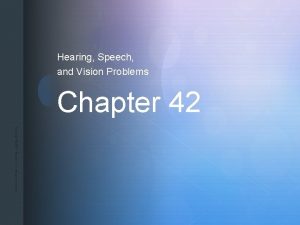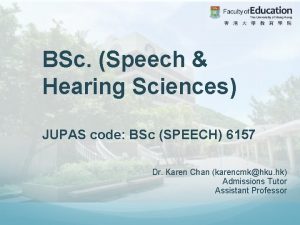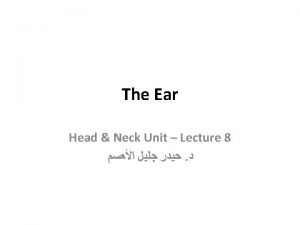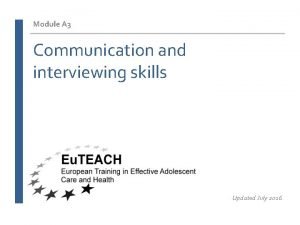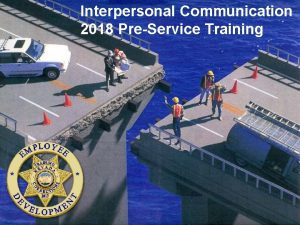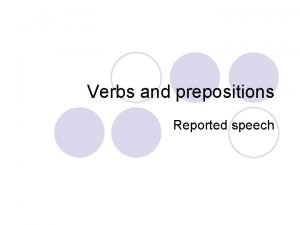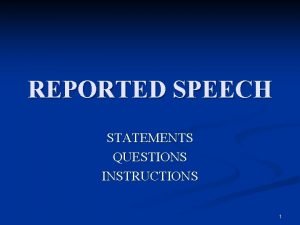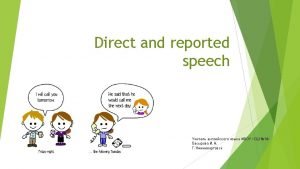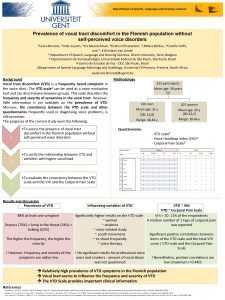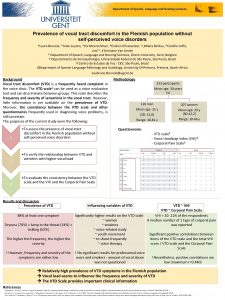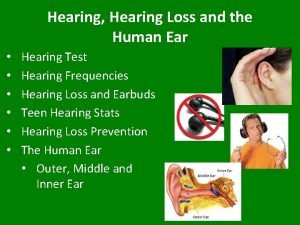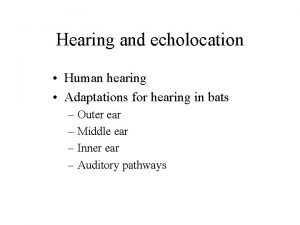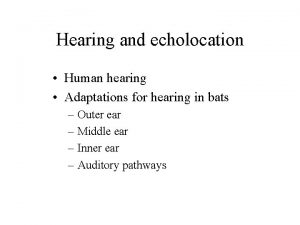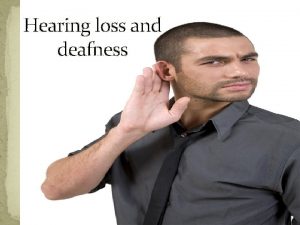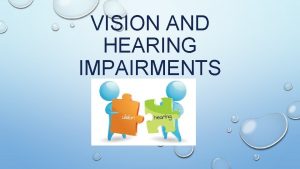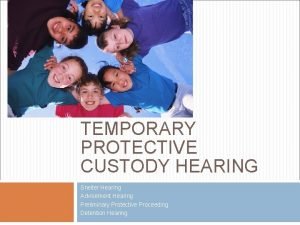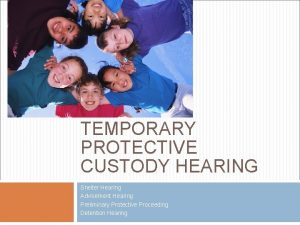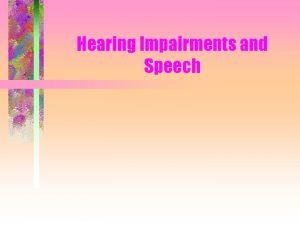Department of Speech Language and Hearing Sciences Language















- Slides: 15

Department of Speech, Language and Hearing Sciences Language Development of Children Born Following Assisted Oocyte Activation Evelien D’haeseleer, D’haeseleer Frauke Vanden Meerschaut, Kim Bettens, Anke Luyten, Hannelore Gysels, Ylenia Thienpont, Griet De Witte, Björn Heindrynckx, Ann Oostra, Herbert Roeyers, Petra De Sutter, Kristiane Van Lierde 29 th World Congres of the IALP – August 25 -29, 2013 Faculty of Medicine and Health Sciences

Department of Speech, Language and Hearing Sciences Background • In Europe, 3. 9% of national births are infants born after Assisted Reproduction Therapy (Nyboe Andersen et al. , 2007) • Neurodevelopmental outcome in ART – Effect of ART on the brain is not clear – Most controlled studies in IVF and ICSI show no increase neuromotor, cognitive, language and behavioral problems (Middelburg et al. , 2008) – Language development is rarely studied in a detailed sense. • New and more invasive techniques – ICSI combined with different activating agents – Absence of intensive follow-up programs 29 th World Congres of the IALP – August 25 -29, 2013 Background

Department of Speech, Language and Hearing Sciences Assisted Oocyte Activation (AOA) • Intracytoplasmic sperm injection (ICSI) – An in vitro fertilization (IVF) procedure in which a single sperm is injected directly into the egg. • AOA www. ivf. com – Highly specialized fertilization technique – ICSI + injection of calcium chloride (Ca. Cl 2) followed by a twofold calcium ionophore exposure of the injected oocyte No evidence regarding its safety and efficacy! No follow-up information! 29 th World Congres of the IALP – August 25 -29, 2013 Assisted Oocyte Activation www. ivf. com

Department of Speech, Language and Hearing Sciences Purpose The main purpose of this study is to investigate the expressive and perceptive language development of 3 -10 -year-old children born following AOA. Secondly, a comparison is made between the language scores of singletons and twins. 29 th World Congres of the IALP – August 25 -29, 2013 Purpose

Department of Speech, Language and Hearing Sciences Methods Participants • 20 children older than 3 y born following AOA – Sex: 6 boys, 14 girls – Twins: 11 singletons, 9 twins – age: Mean: 5; 4 y (SD: 1; 8 y) Range: 3; 1 -10; 4 y – Pregnancy duration: Mean: 38. 2 w (SD: 2, 3) Range: 32 -41 w Premature: 2 children (twin) – Birth weight: Mean: 3187. 5 g (SD: 712) Range: 1640 -4140 g Low birth weight: 4 children (twins) 29 th World Congres of the IALP – August 25 -29, 2013 Methods

Department of Speech, Language and Hearing Sciences Assessment of cognitive development • Children < 7 y Primary Scale of Intelligence (WPPSI-III-NL) • Children > 7 y Wechsler Intelligence Scale for Children (WISC-III-NL) Full Scale Intelligence Quotient Verbal Intelligence Quotient Performance Intelligence Quotient 29 th World Congres of the IALP – August 25 -29, 2013 Methods FSIQ VIQ PIQ

Department of Speech, Language and Hearing Sciences Assessment of language development • Children < 5 y Reynell Developmental Scales Total Language score: Language Comprehension Scale Language Production Scale -Vocabulary -Language Content -Spontaneous Language Production 29 th World Congres of the IALP – August 25 -29, 2013 Methods

Department of Speech, Language and Hearing Sciences • Children > 5 y Clinical Evaluation of Language Fundamentals, CELF-IV-NL Indices: • Core Language Index • Receptive Language Index • Expressive Language Index Subtests: -Concepts and Following Directions -Word Structure (<9 y) -Recalling Sentences -Formulated Sentences -Word Definitions (> 9 y) -Word Classes < 9 y -Word Classes > 9 y -Sentence Structure (<9 y) -Expressive Vocabulary -Semantic Relationships (>9 y) 29 th World Congres of the IALP – August 25 -29, 2013 Methods

Department of Speech, Language and Hearing Sciences Results Cognitive Development n Mean Min Max SD VIQ 20 103. 1 77 129 14. 0 PIQ 20 106. 5 74 142 16. 4 FSIQ 20 105. 8 85 144 14. 9 Normal intelligence scores 29 th World Congres of the IALP – August 25 -29, 2013 Results

Department of Speech, Language and Hearing Sciences Language Development Standard scores (percentile rank) n Mean Min Max SD Total Score/Core Language 20 56. 8 9. 1 99 33. 6 Expressive Language 20 55. 3 7. 1 99 35. 0 Receptive Language 20 55. 0 3. 6 99 38. 9 • General language – Clinical zone for language impairment (< pc 5): none – Subclinical zone (< pc 10): 1 child • No significant differences between expressive and receptive language • Subtests – < pc 10 for two or more subtest: 4 children (two twins) 29 th World Congres of the IALP – August 25 -29, 2013 Results

Department of Speech, Language and Hearing Sciences Comparison between singletons and twins and between two age groups • ANOVA • No interaction effect • No differences between the results of the children younger and older than 5 years • Singletons scored significantly better compared to the twins for – Receptive language skills (p= 0. 007) – Expressive language skills (p=0. 041) 29 th World Congres of the IALP – August 25 -29, 2013 Results

Department of Speech, Language and Hearing Sciences Discussion & Conclusion Language Development • First study investigating the outcome of AOA children • The general language scores of the AOA children in this study are located within the normal ranges. – One child (twin) was located within the subclinical zone of language impairment (pc 9) follow-up • 20% of the children scored below pc 10 on two or more subtests of the language battery. • Cognitive development of all the children was normal 29 th World Congres of the IALP – August 25 -29, 2013 Discussion & Conclusion

Department of Speech, Language and Hearing Sciences Comparison singletons and twins • Singletons scored significantly better for expressive and receptive language skills • Gucuyener et al. (2011): Language delay of 3 months in IVF twins compared to IVF singletons • Possible explanations: – – More obstetric and perinatal complications in twins Different patterns in family interaction Specific language characteristics: cryptophasia More preterm births and lower birth weights 29 th World Congres of the IALP – August 25 -29, 2013 Discussion & Conclusion

Department of Speech, Language and Hearing Sciences Limitations • Absence of a control group of spontaneously conceived children • High response rate small absolute number of children included • Long-term follow-up in the future of these children is necessary 29 th World Congres of the IALP – August 25 -29, 2013 Discussion & Conclusion

Department of Speech, Language and Hearing Sciences Thank you very much for your attention Evelien D’haeseleer, Frauke Vanden Meerschaut, Kim Bettens, Anke Luyten, Hannelore Gysels, Ylenia Thienpont, Griet De Witte, Björn Heindrynckx, Ann Oostra, Herbert Roeyers, Petra De Sutter, Kristiane Van Lierde Ghent University, Belgium 29 th World Congres of the IALP – August 25 -29, 2013 Discussion & Conclusion
 Human sciences tok
Human sciences tok Chapter 42 hearing speech and vision problems
Chapter 42 hearing speech and vision problems Bsc speech
Bsc speech Hearing and equilibrium
Hearing and equilibrium Antomy of ear
Antomy of ear Beach side sight
Beach side sight Physical barriers to listening
Physical barriers to listening Proxemics in communication skills
Proxemics in communication skills Match these sentences in direct and reported speech
Match these sentences in direct and reported speech Pure speech definition
Pure speech definition Quoted reported speech
Quoted reported speech Reported speech simple past
Reported speech simple past Directed speech and reported speech
Directed speech and reported speech Reported speech
Reported speech Quoted speech
Quoted speech Insulated listening definition
Insulated listening definition

